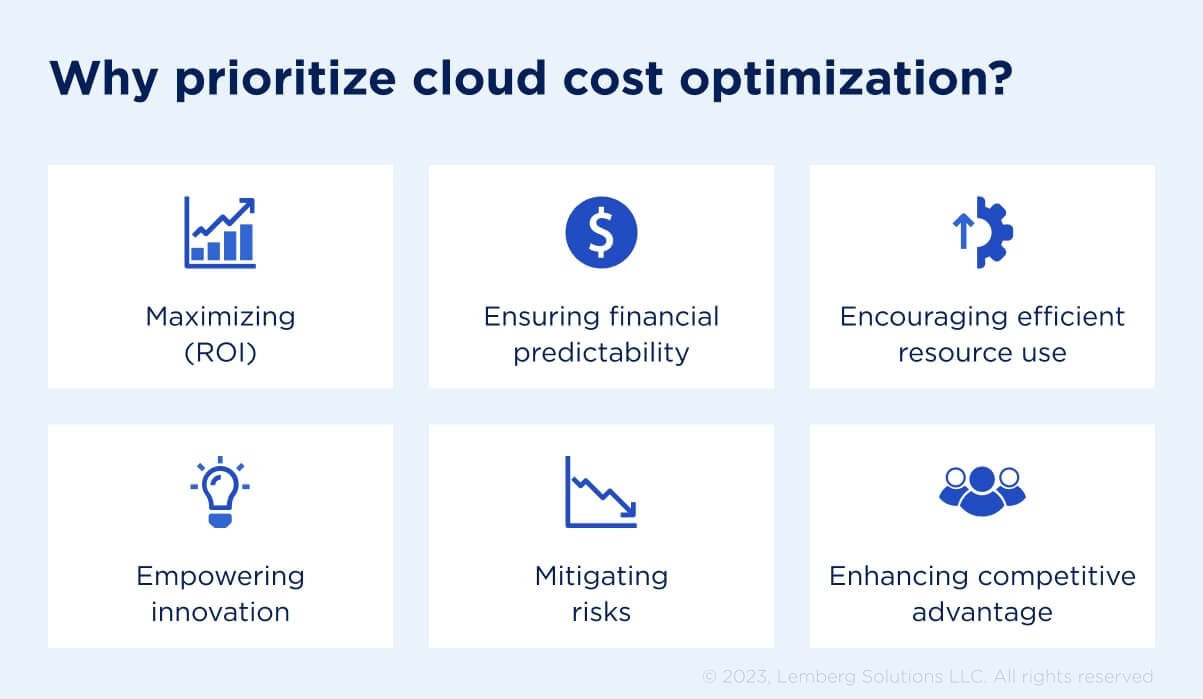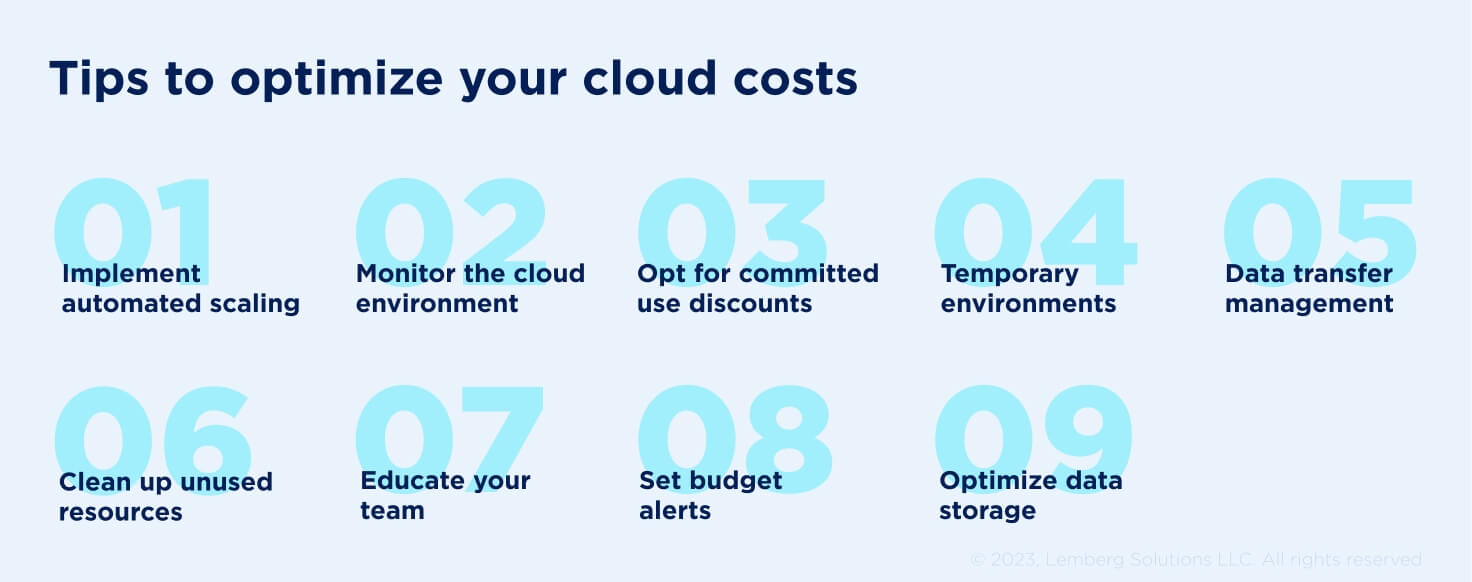Cloud solutions offer numerous benefits, from enhanced scalability to improved accessibility. Yet, as companies migrate their operations and data to cloud platforms, they often discover that managing cloud costs can be challenging. Unchecked consumption, unoptimized resources, and unexpected billing can quickly lead to budget overruns.
In the pursuit of leveraging the cloud's potential while staying firmly within budgets, organizations recognize the need for strategic cost management. Cloud cost optimization is the must-have step to cut such expenses.
In this article, we will explain why cloud cost optimization is important and share the strategies and best practices to optimize cloud spending and ensure cloud cost efficiency.

What is cloud cost optimization?
Cloud cost optimization is the strategic process of minimizing your overall cloud spending by aligning IT resources with business needs. It's not just about cutting costs but about ensuring that spendings bring genuine value to the organization.
Cloud cost optimization involves adapting the capacity of your current cloud resources according to your needs. For instance, when you launch a project using a specific cloud solution, you choose a plan that meets your current needs. With a project growth, this plan doesn’t cover all your requirements. That is when you need to optimize your cloud solution.
Instead of overprovisioning, which leads to unnecessary expenses or shortages, which can harm performance, optimization aims for a balance, ensuring resources align with requirements. Optimization also allows to classify data based on access patterns and importance and move it to cost-effective storage options without compromising performance. This strategy also ensures that you align your budget with your business goals.
In essence, cloud cost optimization is about maximizing the value of your cloud investment. It's a continuous journey that requires regular reviews, adjustments, and a proactive approach. By optimizing cloud costs, businesses can reduce their expenditures and invest in growth and innovation, ensuring they remain agile, competitive, and productive.
Learn more about cloud computing in IoT.
Why you should prioritize cloud cost optimization?
As businesses embrace digital transformation, cloud computing has become a go-to solution for numerous companies. The cloud offers flexibility, scalability, and innovation opportunities, making it a key component in modern tech strategies of various businesses.
However, businesses face some challenges when leveraging cloud environments, one of which is managing and optimizing costs. Good news is — you can overcome this challenge with cloud cost optimization. Here are some cloud cost optimization benefits:

Maximizing return on investment (ROI)
While cloud providers offer scalable resources, cost optimization allows businesses to pay exactly for what they use. By managing cloud expenses, companies can ensure they get the best value for each service, enhancing their ROI.
Ensuring financial predictability
Fluctuating prices in cloud bills confuse businesses since they cannot operate within a specified budget. Prioritizing cost optimization means bringing predictability to cloud expenses. This allows for better financial planning and reduces the risks of unexpected budget overruns.
Encouraging efficient resource use
Cost optimization goes hand-in-hand with resource efficiency. When keeping track of your costs, you become more aware of idle resources. This can lead to improved performance and efficient use of resources.
Empowering innovation
You can channel the savings from cloud cost optimization back into the business, whether it's investing in research and development, expanding into new markets, or enhancing customer experiences.
Mitigating risks
Overlooking cost optimization can lead to uncontrolled spendings, which results in a lack of stability. By being proactive in cloud cost optimization, businesses can prevent financial risks associated with unchecked cloud resource consumption.
Enhancing competitive advantage
In highly competitive markets like IoT, the ability to control costs while maximizing output is a key to success. Organizations that manage their cloud expenses can reinvest their savings, gaining an edge over competitors who might struggle with rising costs.
Cloud cost optimization isn't just a measure to control spending — it's a strategic move that can push an organization forward in multiple dimensions.
9 tips to optimize your cloud costs
Cloud solutions promise scalability and flexibility. However, without vigilant management, costs can increase rapidly. For businesses seeking to leverage the cloud's benefits without overspending, here are some strategies to effectively optimize cloud cost:

1. Implement automated scaling
Leverage the cloud's auto-scaling features. By automatically adjusting resources based on current demand, you ensure you're not overpaying during periods of low usage or demand. Your team won’t spend time manually checking the traffic spikes. With autoscaling, you will receive seamless resource activation and shutdown. This way, the server will regulate the demand without your intervention.
2. Monitor and analyze the cloud environment regularly
Employ cloud cost management tools that provide insights into your spending patterns. Regular reviews will highlight areas for potential savings and alert you about unexpected costs. Moreover, try to monitor your data from a single account to have the most accurate results. You can also monitor your cost history and create regular reports to make sure you don’t exceed the budget.
3. Opt for committed use discounts
Many cloud providers offer substantial discounts for businesses willing to commit to long-term usage. If you’re confident in your usage patterns, use the discounts. For example, Google Cloud offers committed use discounts tailored to your predictable workloads. With this cloud provider, you can secure hardware commitments for various resources such as vCPUs, GPUs, memory, and Local SSDs. The discounts can reach a 57% reduction in costs for most resources (like GPUs), while memory-optimized machine types can reach a 70% discount.
4. Temporary environments
For development and testing, create environments that exist only for as long as you need them. By tearing down these environments after use, you avoid spending costs for unused resources.
5. Data transfer management
Data transfer can be costly. Minimize the transfers where possible, and always be aware of associated costs. Cloud providers can charge you to shift data from their platforms. By evaluating the prices and regulating the cloud architecture, you will minimize data transfers. For instance, you can move on-premise applications that regularly access cloud data to a specific cloud.
6. Clean up unused resources
Regularly review and eliminate unused resources, like unattached storage volumes or outdated snapshots. These often accumulate and result in unnecessary charges.
7. Educate your team
Make sure that everyone involved in using cloud resources is aware of the costs. Regular training and awareness sessions can prevent unintentional overspending.
8. Set budget alerts
Configure notifications that alert you when spending reaches or exceeds predefined thresholds. This early warning system can prevent cost overruns.
9. Optimize data storage
Instead of using high-performance storage for all data, classify data based on usage patterns. Store frequently accessed data on higher-performance tiers and move rarely accessed data to cheaper storage. This approach simplifies data archiving, backup, and retrieval procedures, allowing you to operate with greater efficiency and agility in the dynamic cloud environment. You can also change the pricing tiers of the storage services to find more effective and cost-saving solutions and ensure elasticity.
By implementing these strategies, businesses can cultivate a cost-efficient cloud environment that provides both operational excellence and financial balance. The key is consistent monitoring and adjustment in response to the specific needs of the business.
Best practices to optimize your cloud costs
To ensure that you derive the most value from the cloud investments, read about the additional cloud cost optimization strategies.
Thoroughly understand pricing models
Cloud providers offer a myriad of pricing options. Whether it's on-demand, reserved instances, or spot instances pricing, understanding each model allows you to select the best fit for your needs.

Leverage cost management tools
Cloud providers and third-party vendors offer tools that provide detailed insights into your spending. These tools can help identify areas of inefficiency and offer recommendations for cost-saving. For example, you can use AWS Pricing Calculator, AWS Cost Explorer, AWS Budgets, and AWS Cost and Usage Reports.
Implement right-sizing
Regularly evaluate your resource allocations. Ensure that you use the appropriate size and type of resource for your workload. Avoid over-provisioning, which can lead to unnecessary spending.
Adopt a multi-cloud approach
By diversifying your services across multiple cloud providers, you can capitalize on the best-priced services and features each has to offer. That is why you shouldn’t limit yourself to one cloud platform and service.
Establish governance and policies
Define clear cloud usage policies. This includes setting up resource naming conventions, tagging standards, and access controls. Such measures help in tracking and managing costs more efficiently.
Schedule resources for irregular workloads
If certain workloads don't need to run 24/7, schedule them to run only during business hours or specific intervals. This can result in significant savings.
Use heatmaps
Monitor your instances’ performance and memory usage with heatmaps. Visual tools can quickly highlight underutilized or idle resources, guiding you toward potential cost-cutting areas.
Consider cost when selecting server regions
Cloud providers often have different pricing for different regions. If your workload allows, you might find cost savings by hosting in a less expensive server region. Better choose to store your data in your local business region. For example, if you are based in Europe but store your data outside of Europe, the fare can be high.
Regularly review and clean
Periodically audit your cloud environment for unused resources like idle virtual machines, unattached storage, or obsolete backups. Clean them to eliminate unnecessary spendings.
Opt for modern architectures
Consider serverless architectures or containerization. These models only charge for the actual compute power or runtime you use, which can be more cost-effective than traditional models for certain applications.
Stay updated
Cloud providers frequently update their services, introduce new features, or adjust pricing. Keeping informed about these changes can present new opportunities for savings or improved performance at a reduced cost. You can consult with a professional cloud development team to learn about the best offers and changes on the market.
Cloud spend optimization demands regular attention and proactive management. By incorporating these best practices, businesses can strike the right balance between performance and cost, maximizing the value of their cloud investments.
How can we help with cloud cost optimization?
To optimize cloud costs, we analyze your existing solution and services, including the service prices, to find out the most optimal variants. Our cloud engineers will search for analogous solutions that meet your requirements and offer more flexible prices. We can estimate the smaller services you apply and provide a solution where these services are combined and less expensive but provide the similar capacity.
We will search for more optimal ways to make your cloud solution work. Our team evaluates how you leverage certain services and searches for the gaps that can be addressed to optimize your solution.
Our team will set up cloud monitoring so you can receive notifications if your cloud solution exceeds the budget. Moreover, we will check more cost-effective plans to optimize your solution regularly. Our cloud engineers audit whether optimization works as planned and adjust it if the prices or resources grow.

Takeaway
While the cloud offers an array of advantages that range from flexibility to innovation, it also presents potential pitfalls, such as runaway costs. However, proactive cloud cost optimization guides organizations toward improved resource management. By carefully monitoring cloud usage and resources, businesses can maximize the value extracted from their investments. Cloud cost optimization is about empowering businesses to scale, innovate, and compete in the digital age without compromising their financial stability. As the cloud continues to shape the future of business, those who master cloud cost optimization will help their business thrive.
If you need to optimize your cloud costs, don’t hesitate to contact us!



